| |
| Christmas
|

|
4Kids |
| Pease
note: This is for people 10 years and younger.
But parents may
have to help with the reading.
And, parents
are actually encouraged to participate.
|
Table of Contents
Santa
Claus
Around the World!
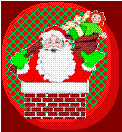
|
Yuletide
Traditions

|
| Christmas
Traditions

|
Christmas
FAQs
4 Kids |
Foreword
|
What
does the word "Christmas" mean?
*
The word "Christmas" is a compound word. That means it is made
of two smaller words. They are: Christ + mass.
*
Christmas happens on Jesus Christ's birthday (December 25th).
*
Mass means a holy Catholic church service.
*
Christmas has evolved into a whole
season that lasts a whole month from around November 25th to December
25th.
|
|
What is Yuletide?
The word "Yule" was originally a Scandinavian
word (in Finnish it is spelled: "Joul", but pronounced the same way). Scholars say that Yule probably means
'feast', and "tide" means time (as in a period of time).
Therefore, "Yuletide" is the feasting time.
It was originally a Scandinavian winter solstice
tradition, but now is part of the Christmas traditions.
Who knows exactly how long the full Yuletide lasted?
But,
the most important time was from December 22nd to December 25th. Solstice
means Sol (sun) stands still for three days: 22nd, 23rd, and 24th.
On December 22nd--the winter
solstice--when the sun was lowest in the sky (for the Northern
Hemisphere), it was thought that the sun was close to death. It
was the tradition to keep a yule log (or yule logs) lit for three days
to re-ignite the sun. On December 25th, when the sun started to
appear higher in the sky, it was thought to be the "Birthday of the SUN".
In modern times, for those who actually have fire places, it is a
tradition to light the Yule Log on Christmas Eve.
|
Santa Claus
Around the World

"Santa on His Sleigh"
Image created by A.I. and Leon
|
IMPORTANT NOTE:
Before you read all about Santa Claus around
the world, it is important to answer the age-old question:
"How does Santa Claus
deliver all those presents on one night?"
The answer is: He doesn't.
In the Netherlands (Holland), he delivers them
on December 5th. In Poland, he delivers them on December
6th. In Russia, Mongolia, (and probably all old Russian satellite states
as well), Santa delivers them on January 1st. In Spain (and probably all
Spanish-speaking countries) Santa Claus gives the presents to the 3 Magi (AKA:
The 3 Wise Men) to deliver for him. In Armenia, Christmas is celebrated on
January 6th, but Gaghanta Baba (The Armenian Santa Claus) brings gifts for the
children on New Year's Eve (December 31st).
| Country
/ Picture |
Name
/ Description |
| Scandinavia
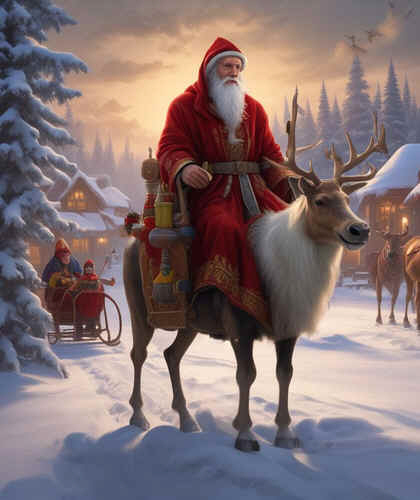
"Yule Buck"
Image created by A.I. and Leon.
|
Joulupukki
All Finns know that Santa Claus was born in
Finland. Then, he met the gnomes/elves
who made toys. Then, they all moved to the North Pole.
All Scandinavians call Santa Claus "Joulupukki"
which literally means "Yule Buck", because he originally rode a
buck. Of course, over time Santa
gathered more reindeer and a sleigh to put all the presents in. Do
you know how many reindeer make up Santa's team now? |
| Russia
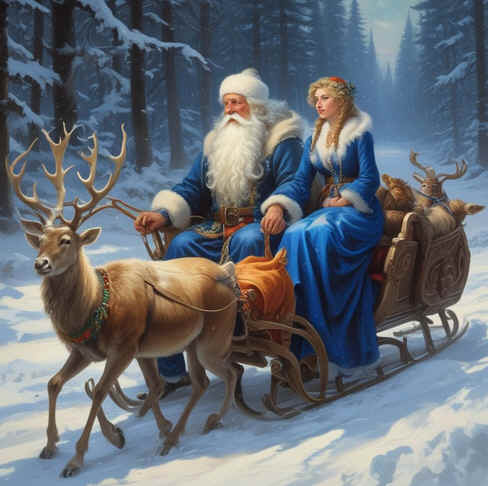
"Granddad Frost & Snow Maiden"
Image created by A.I. and Leon.
|
Ded
Moroz
(and the Snegurochka)
In Russia, Santa is
called "Ded Moroz," which means "Grandad
Frost".
And he is helped by
the Snow maiden to deliver the presents.
Of course, the elves
make the presents, but the Snow maiden helps deliver the presents. |
| Mongolia

Image borrowed from the web.
|
Uvliin
Uvgun
The Mongolians call
Santa Claus Uvliin Uvgun, which means Grandad Winter.
He delivers presents
to the children on New Years day.
|
| Europe
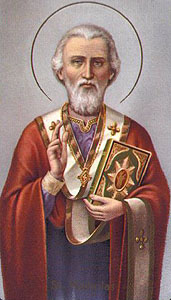
Image borrowed from the web.
|
Saint
Nikolaus
In Europe, they call
Santa Claus, "Saint NiKolaus" or "Saint
Klaus" for
short. He was always good to children. In fact, he is the patron
saint of children.
In English, we call
him, "Saint Nick". |
| Germany
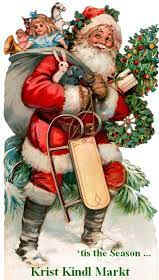
Image borrowed from the web.
|
Krist
Kindl
In Germany, Santa
Claus is called "Krist Kindl".
In English, we call
him "Kriss Kringle." |
| France
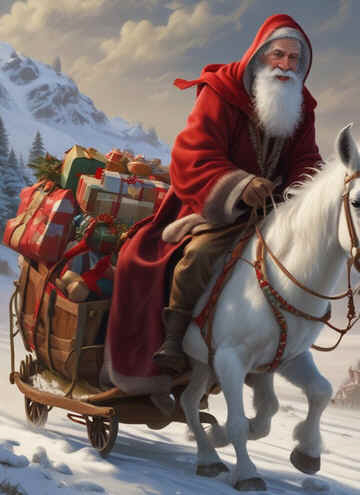
"Papa Noel"
Image created by A.I. and Leon.
|
Papa
Noel
In France, Santa
Claus is called Papa Noel (Papa Christmas) or Pere Noel (Father
Christmas). Noel literally means the Nativity (which refers to the
birth of Christ, but that's how they say, "Christmas" in their
language). In France, they say that Papa Noel used to ride a donkey
before he had reindeer. Also, Papa Noel used to wear a red hooded
cloak before he got the suit he wears today (made by the elves). |
| Spain
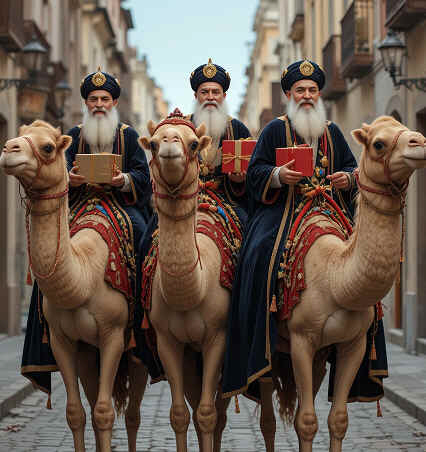
"The Three Magi"
Image created by A.I. and Leon.
|
Papa
Noel & The 3 Magi
In Spain, Santa
Claus is also called Papa Noel (Father Christmas) just like in
France. But, in Spain (and pretty much all Spanish-speaking
countries) Santa Claus lets the 3 Magi bring the gifts that he and his
elves make to the children.
The 3 Magi were
priests of a Persian highly-educated class which believed in the
Zoroastrian religion. (Learn about
Zoroastrianism on Leon's planet on his science
page).
The word "magi" is the plural of the word "magus" (a
Greek translation of the Persian word "magush" from which we get
the English word "magician"). That would imply that they
had magic powers, but as I tell my son, magic is merely science that we
don't understand. So, in my mind, they were scientists. They
studied everything, including the stars, and when they saw a new bright
star in the heavens, they knew that it meant that a great king was about
to be born. So, they followed the star to Bethlehem and gave gifts
to the baby Jesus. Those gifts were the very first Christmas gifts,
and so it seems fitting that they should be the bearers of Christmas gifts
to children in Spanish-speaking countries. |
| Italy

"Babbo Natale & Bambino Gesu"
by
Leon and A.I.
|
Babbo
Natale & Bambino Gesu
In Italy, Babbo
Natale (Father Christmas) and Bambino Gesu (The Christ Child) team up to
deliver gifts to the children on night of Christmas Eve and Christmas
early morning hours.
But, wait!
That's not all. In Italy, there are a total of five gift-bringers
during the holiday season. (Must
be good to be a child in Italy!)
NOTE: This may differ slightly by region of Italy. But, here
they are:
1) On December 6th, San
Nicolo brings gifts.
2) On December 13th;
Santa Lucia can bring gifts of health (to those who ask for them).
3 & 4) On
December 25th; Father Christmas and Jesus bring gifts.
5) On January 6th
(which is "The Epiphany" when the 3 wise men found the baby
Jesus and offered their gifts to him); Befana brings gifts.
NOTE: The word
"Befana" is etymologically from the word ePiphany (where the
initial sound is dropped making it Piphany). Befana is an old woman
with a broom, but she is not a witch. She is the personification of
the Epiphany itself. SOURCE:
Rossi
Thomson.
...and google A.I. mode. |
|
Yule
Traditions
that
are
adopted into Christmas Traditions
by
Leon
Did you know that
most of our Christmas traditions come from the winter solstice traditions
of the Northern Hemisphere? In this article,
we shall explore the various winter solstice traditions that have been
adopted as Christmas traditions.
What
is Winter Solstice?
Winter
begins with the winter solstice in the Northern Hemisphere. That day
happens on the 22nd day of December in the
Northern hemisphere. It is the day when the sun is lowest in the sky and
daylight is shortest. The word
“solstice” is a compound word from Latin:
sol
(sun) +
stice
(stands still).
That
means that the sun stays low in the sky for 3 days. Our
ancestors said that the sun was dead (or almost dead) for 3 days.
Then, miraculously it was born again on December 25th and it
started to rise higher and higher in the sky. It keeps rising higher
and higher in the sky until June 21st or 22nd.
That's called the Summer solstice.
The
Scandinavians had many winter solstice traditions that are called
"Yuletide".

The
Christmas-Yule Tree's Origin
The
Scandinavians are people who live in the Northern countries of Europe,
like Finland, Sweden, Norway, Denmark, Iceland, and Holland. During
winter solstice time they decorated a Yule tree with trinkets of their
gods.
Language
scientists (which are called Linguists) say that the Scandinavians probably moved
northward from Germany a long, long time ago, because their languages are
all related.
And,
guess what! Germany had Yule trees as well. They just
decorated them differently. The Germans decorated their trees with
apples--both red apples and golden apples. (Learn more about apple
lore on Leon's Planet).
By
some accounts, this tradition of putting up a tree and decorating it
during Yuletide stemmed from the time (long, long ago) when all the people of the Europe
and the middle East were one people under the rule of a king named
Nimrod. Nimrod was a great king and when he died, his mother became
the ruling queen. She insisted that everyone remember her son by
putting up a tree and decorating it with silver and gold on her deceased
son's birthday, which was December 25th. I don't know if this story
is true or not (because it's not in the Bible). But, it could be
true. The Bible does say (in Jeremiah) not to be afraid of decorate trees with silver and
gold (which were worshipped by the heathen as idols). The Bible does
NOT say not to put up a Christmas, it just says don't worship it.
The Christmas tree is not an idol. It reminds us to be kind and give
gifts to others (especially during Christmas time).
If you want to decorate your tree with angels or apples or homemade
ornaments or lights, I don't see anything wrong with that. It's not
the tree that is bad, it is the purpose of the tree. If you have a
tree to celebrate Nimrod, that's bad. If you have a tree to
celebrate Jesus, or Santa Claus, that's good. I decorate my tree
with ornaments and stockings; And, I put an angel and a star on the top.
To me the angel represents the angels that appeared to the shepherds
heralding the birth of Jesus. To me the star represents the star of
Bethlehem. But, to the Mongolians, the star represents something
different. (Learn more below in the next section).
Mongolian
Winter Solstice Tree
According
to an article by Jade Wah’oo Grigori, entitled:
“A Time of the Shaman’s Gift Bringing;” the traditional
Mongol winter solstice is a very, very, meaningful and important time
for all Mongols who still follow the old ways (and not many still follow
the old ways).
It is written that the Mongol village shaman was very central and important to the winter solstice ritual.
In the past, Villagers would gather at the shaman’s ger,
which is a circular tent. In English, we call it a "yurt"
and we get that word from the Turkish language, because the Turks also
lived in circular tents long ago.

Mongolian ger
A ger has a central pole which represents the ‘mother tree’,
called “Ej mod,” (pronounced
'Edge Mud'). It is called other things too, like the “Tree of Life” and the
“Pole of Ascension.” The
ger’s ceiling is supported by 81 ribs, representing the 9-times-9
pillars which hold the heavens apart from the earth.
The ‘mother tree’ points to the North Star, figuratively of
course. So, at the top of the
‘Tree of Life’ sits the ‘Star’.
Is
that the origin of our "Christmas Tree" tradition or does it go
back even further in time to King Nimrod? You decide.
_______________________________________________________________________
More
Yule
Traditions

Yule
Log
Scandinavian tribes had
amongst their Yuletide traditions, they had the Yule Log tradition.
They had to keep a fire going all night long on the night of December
24th, and the fuel for the fire was called "The Yule Log".
Why
must one keep the Yule log burning all night on the 24th of
December? The answer is to
re-ignite the Sun. The fear was that if one did not keep the Yule log burning all
night long, the Sun would not be reborn on the 25th of December.
As a result, the world would plunge into eternal darkness. My question: If we keep the
Yule log burning all night long, how does Santa get down the
chimney? Answer: In Scandinavia, Santa doesn't come down the
chimney. He knocks on the door, and asks, "Are there any good
children here?"

The
Mistletoe Tradition
Why
do we hang mistletoe at Christmas time?
It is because of the Scandinavian myth about Balder and Loki.
Balder was the god of
light (who represented the sun at winter solstice). He represented the
sun
at winter solstice time. Loki was the god of
mischief and undoing. He always tried to undo what the other gods
had done.
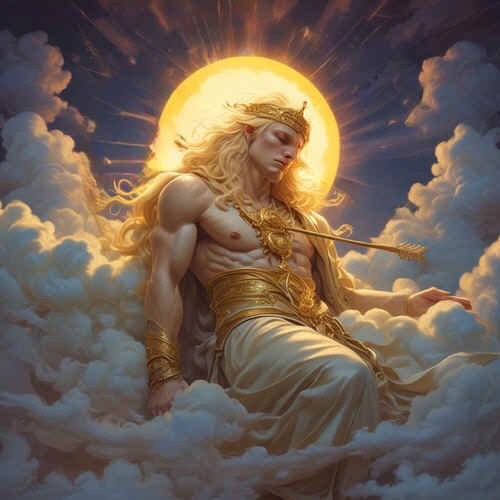
This is Balder (the sun god)
who dies every winter solstice
[Image created by A.I. and Leon
c.2025 all rights reserved.]
Balder,
Loki & Mistletoe
The myth goes like this:
Balder’s mother,
Frigga (which means "Love") had asked all the plants,
animals and minerals of earth never to
harm her son, Balder. However, there was one plant that she overlooked; it was
mistletoe. Frigga said she
overlooked it because it was so soft and wouldn't hurt anything.
Over time, Loki became jealous
of Balder’s popularity and he was annoyed by the noise devoted to
Balder’s praise. So, he
secretly disguised himself as an old hag and visited Balder’s mother and
asked her many questions about Balder. Eventually, he found out that there was one
living thing
on Earth that she had not made promise never to harm her son: mistletoe
(because it was so soft that she didn't think it would hurt her son).
Loki then made an arrow out of mistletoe; and one day when the gods
were hurling various things at Balder, just to see how nothing could hurt
Balder.
Loki, disguised as an old hag, gave the mistletoe arrow to
Hod (a blind god) to hurl (or shoot) at Balder, and it killed
Balder.
Everyone,
except Loki, were shocked and greatly saddened by
Balder's
death.
But, perhaps no one was more saddened than
Frigga.
Immediately,
Balder’s
mother sent
Balder's
brother,
Hermod, to go into the Underworld to rescue
Balder, and
three days later (on December 25th) he was resurrected
by
Frigga. Finally,
Frigga
made mistletoe promise to never harm another living
thing. This is why mistletoe
is used as decoration at winter solstice time.
It is the symbol of peace and love and tranquility. You see,
December 25th is not only the day that we celebrate Jesus' birth, but also
Balder's rebirth. It's a double WIN-WIN scenario. Two for the
price of one!
The
truth is that nobody knows Jesus' actual birthday, as it was not recorded
in the Bible, so the powers-that-be decided that the birthday of the sun
would be a good day to celebrate the birthday of the Son.
|
| A
Christmas wish from Leon...
Finally,
as we approach the coming winter solstice, may our hearts and souls be
purified by the light of the Great Spirit; may Sun be reborn again to give
its life-giving light unto the world for another year; and may we all
experience eternal love, peace, and tranquility.
Post
Script
There are some people who refuse to celebrate Christmas, because it's
not really Jesus' birthday. In my family, we never celebrated
anyone's birthday on their actual birthday. We would always wait
until the following Sunday to celebrate their birthday. Did it
make the day any less special? No! It was just as special
even though we didn't celebrate our birthday's on the actual day.
Therefore, I say it doesn't matter which day we celebrate Jesus' birth. P.S.#2 Leon
has a page where you can learn all about Scandinavian (Norse)
mythology. Please check it out...
Scandinavian
Lore/Mythology
|
Modern X-mas Traditions
Decorating
the Houses with Lights:
Every year, right after Thanksgiving
(generally during Thanksgiving weekend, but sometimes before),
Americans decorate the exterior of their homes with lights, which
stay up until after Christmas day (sometimes until New Year's Day).
This probably originated with the festival of lights, which occurred in December of each year.
It seems to be the general
consensus that this tradition came from the Roman winter solstice tradition
called Saturnalia, but many cultures have had (as some still do) a festival of
lights. Hanukah is a festival of lights. Diwali is a festival of
lights.
Source: Wikipedia
Christmas
Caroling
(Anciently: Wassailing)

The
tradition of Christmas caroling for food/drink (as in the traditional carol:
"We wish you a merry Christmas") comes from the Celtic tradition of
Wassailing. Wassailing apparently was the practice of singing to wish
fellow farmers well in the upcoming planting season, for which they were
rewarded by a cup of wassail (an alcoholic drink).
For the lyrics of some modern Christmas carols/songs,
click here.
|
X-mas
FAQs
|
| Q1.
Why is Christmas sometimes written "X-mas"? |
| A1. Because
"Christ" in Greek is written: "Xpist";
So, Christ-mas became X-mas. |
| Greek: |
 |
|
|
|
| Q2. Why are green
and red the colors of Christmas? |
| A2. Good question! I don't think
anybody really knows anymore. But, if I had to guess, I'd say, that green
represents the evergreen Christmas tree, which represents eternal life.
Red usually represents blood. It might represent the blood that Christ
gave so that all might have eternal life. But, I'm just guessing. |
|
|
| Q3. Why does Santa come down chimneys? |
|

|
| A3. Coming down the chimney probably started
because doors are usually locked at night, and Santa doesn't want to wake
everyone up by knocking on the door. But don't worry about the
Yule Log, Santa won't get burned, because he has magical powers. |
|
|
| Q4. What if somebody lives in an apartment
or house with NO chimney? |
A4: Parents have to stay awake until Santa
comes and let him in the door.
OR, Santa can just use his magic to get into the house. |
|
|
| Q5. What is the best Christmas present
(to give)? |
| A5: Put yourself in the shoes of the person
for whom you want to give a present, and think about what he/she would like to
receive for Christmas. That is the best Christmas present. |
|
|
| Q6.
Why does Santa put Christmas presents in stockings? |
| A6: This
tradition comes from the countries that call Santa "Saint Nikolaus"
or "Saint Klaus". Children leave either shoes or
stockings by the fireplace for Saint Klaus; or if they don't have a
fireplace, they leave them in front of the door of the house. And
Santa fills their shoes or stockings with treats. And, guess
what! Santa Claus means Saint Klaus. |
|
|
| Q7.
Why do elves make toys? |
|
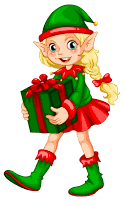
|
|
A7: Well, first off, not all elves
make toys, just some elves. But, there is one thing that is common amongst
all elves; elves like to help the good humans. That's just what they
do. But, to bad humans they play tricks on them. Santa Claus was a
very good human and they decided to help him make children all around the world
very happy by sharing their toys.
Learn more about the little people all around the
world on my "Little People Page".
|
|
|
| Q8. What about family traditions
associated with Christmas? |
| A8: Yes, each family has its own traditions
for Christmas. Each member of my family was allowed to open one
gift on Christmas eve. Also, we had a big feast on both Christmas eve AND
Christmas day. |
|
|
| Q9. What are some traditional foods
associated with Christmas? |
|
A9: There are only a few food that
are particularly associated with Christmas. They are:
- fruit cake (which I could live without)
- sugar cookies (which are cut into shapes of X-mas symbols; very
delicious!)
- figgy pudding {...according to the ol' X-mas carol; I've never tried
it. Now, one must understand (if one is from North America) that in the
old days (and still in the UK and most of its "commonwealth") pudding
was/is a kind of muffin. Thus, figgy pudding would have been a muffin with
fig-treats in it.}
- goose or turkey (Like Thanksgiving, the main course tends to be a big bird;
traditionally a goose or turkey, but duck, or chicken can be
substituted; In our family, turkey was eaten instead of goose.)
|
|
|
| Q10. How do reindeer fly? |
| A10: First
of all, let's understand that not all reindeer fly. Only Santa's
reindeer can fly, and they can fly because of Santa's magic. |
|
|
| Q11. How do
they say "Merry Christmas" in other countries or languages? |
A11:
Britain: Happy Christmas
Dutch: Vrolijk Kerstfeest [Vrolick Kerstfaest]
Filipino: Maligayang Pasko [Mahlee-gahyahng Pahskoh]
Finnish: Jyvaa Joulua [Hoo-vah Yoh-oo-lua]
French: Joyeux Noel [zsho-eh-you No-el]
Gaelic: Nollaig Shona [Null-eg Hunna]
German: Frohe Weihnachten [Fro-ah Vigh-naukten]
Greek: Kala Christougenna [Kahlah Huristo-yennah]
Hawaiian: Mele Kalikimaka [Mehleh Kahleekeemahkah]
Irish: Nollaig Shona [Null-ig hunnah]
Italian: Buon Natale [Bwohn Nahtahleh]
Korean: SongTanJeol Jal Bonaeseyo [SohngTahnJull Jall Bohnehsehyoh]
Mongolian: Zul Sarin Bayar Mend [Zool sahreen Bahyar Meend]
Norwegian: God Jul [Good Yule]
Polish: Wesolych Swiat [Vehso-wich sviaht]
Portuguese: Feliz Natal [Felleese nahtall]
Russian: S Rozhdestvom [srohz-niest-wohm]
Spanish: Feliz Navidad [Felleese nahveedahd]
Swedish: God Jul [Good Yule]
Welsh: Nadolig Llawen [Nahdohlig
Shah-wen] |
| Q12.
How does Santa eat all those cookies and milk that children leave out
for him? |
| A12: Santa
works hard, and he needs energy to get all that work done in time, so
you are helping him have plenty of energy to go to the next house.
Oh! And don't forget carrots for the reindeer. |
|
The End
|
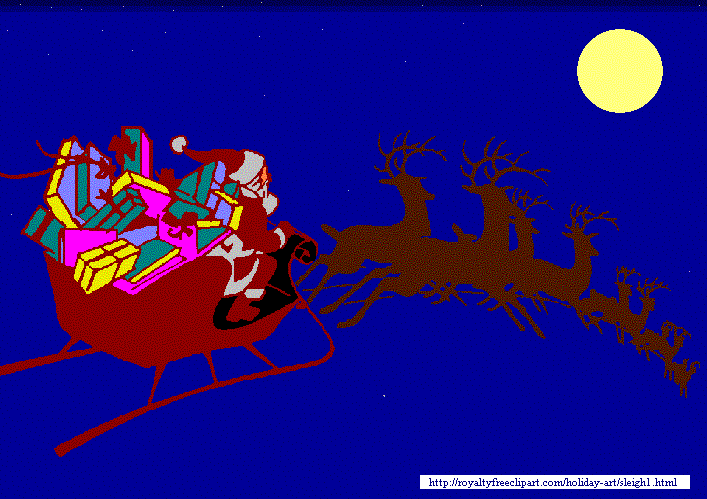
A
Merry Christmas to all, and to all a goodnight!
See also, Leon's webpage about...
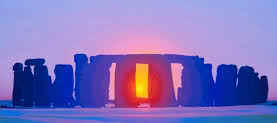
Winter Solstice Traditions Around the World
NOTE: FOR the PARENTS' VERSION of THIS
PAGE
with more details about the origins of Christmas traditions (like Santa) that
would definitely not be interesting for little eyes/ears, check this page out...
Adult Christmas Page.
| |

English |
|

Spanish
|

Korean |

Mongolian |

Chinese |
|

Parents of
Homeschool
|
|

Halloween
|
|

Thanksgiving
|
|
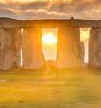
Winter Solstice
|
|

Christmas
|
|

New Years
|
|
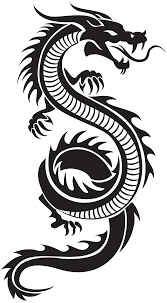
Chinese Lunar
New Year
|
|

Valentine's
|
|

|
|
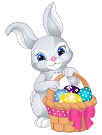
Easter
|
|

All About
Dr. Seuss
|
|
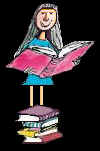
Roald Dahl
|
|
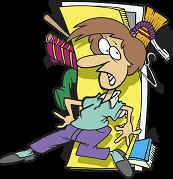
Prepper's
Pen |
|

Ways to
Help
Leon's Planet
|
|